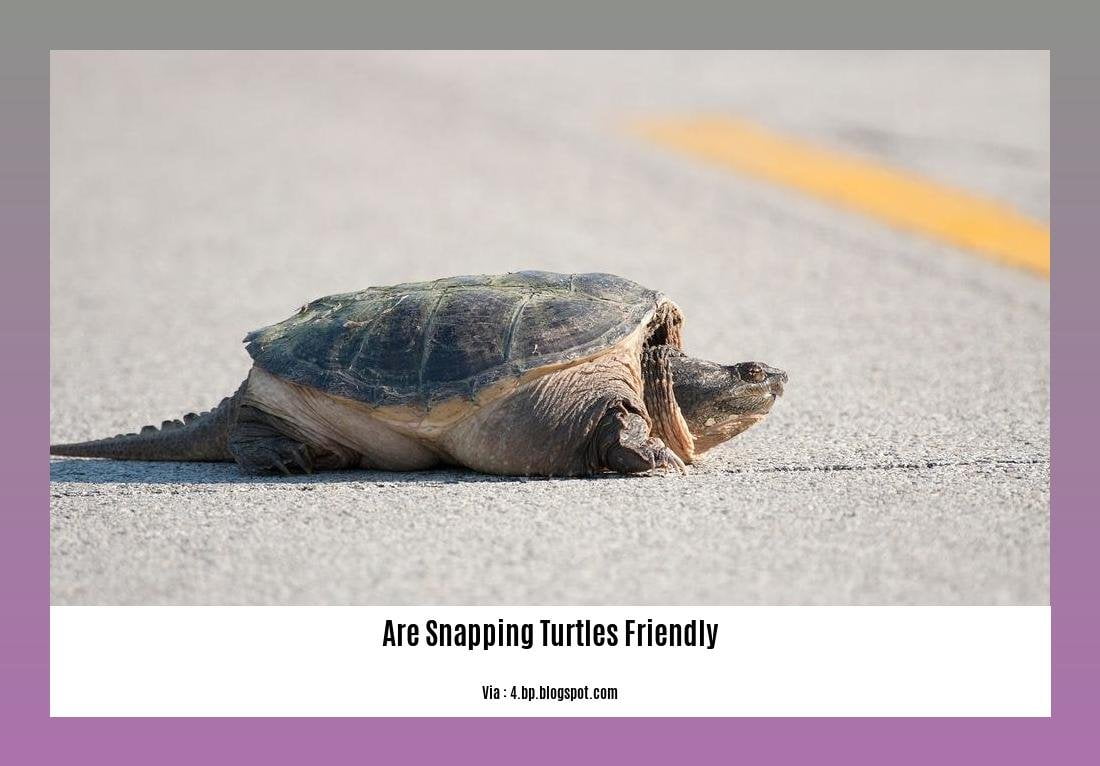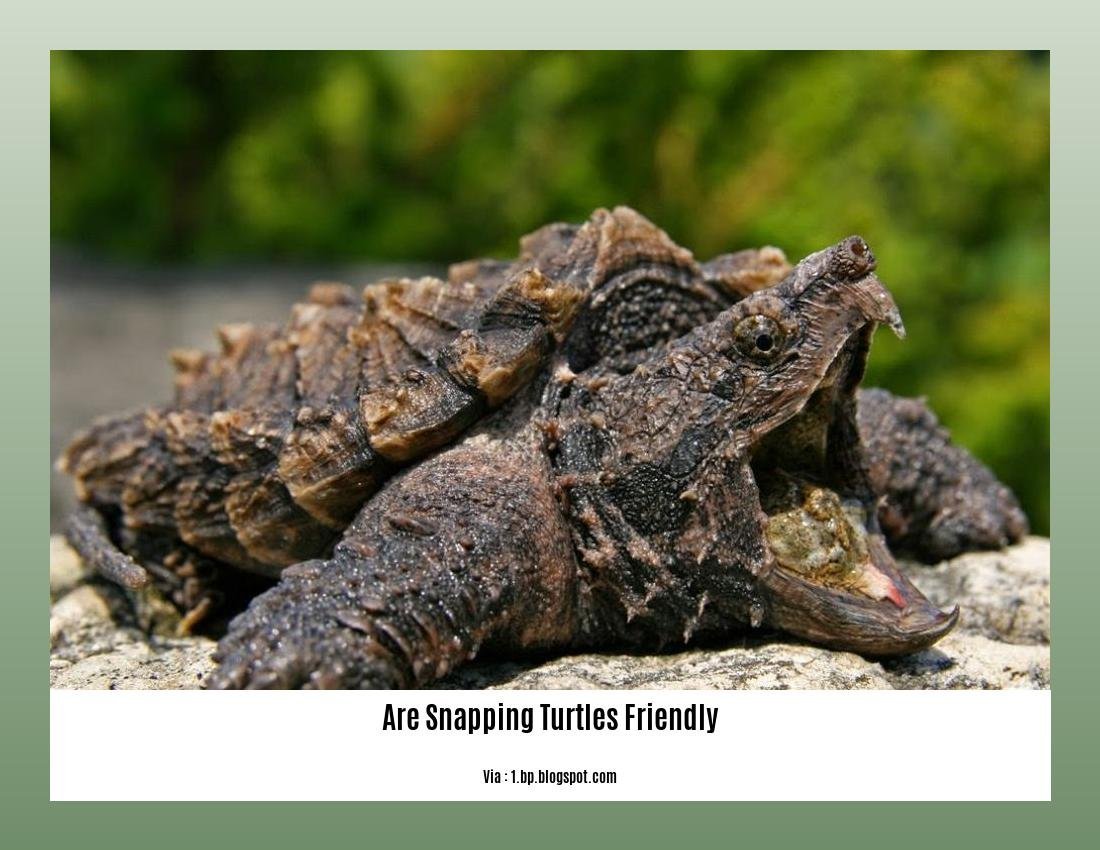Are Snapping Turtles Friendly? Exploring the Misunderstood Nature of These Ecosystem Guardians
Discover the truth behind the reputation of snapping turtles in this intriguing exploration of their misunderstood nature. As we delve into the characteristics and behaviors of these intriguing creatures, we aim to answer the burning questions: can snapping turtles be friendly? Do they attack people? Can they show affection? Additionally, we will also explore the pros and cons of having a snapping turtle as a pet. Prepare to have your perceptions challenged and gain a deeper understanding of these remarkable ecosystem guardians.
Key Takeaways:
– Snapping turtles are not considered friendly pets due to their aggressive behavior and biting tendencies.
– Handling snapping turtles requires caution and proper techniques to avoid potential injuries.
– Snapping turtles prefer solitary lives in the wild and are often found underwater.
– In captivity, snapping turtles still exhibit aggressive behavior and should be considered “look and no touch” pets.
– Prospective owners should have experience in turtle care and be prepared for the long-term commitment and costs of keeping a snapping turtle as a pet.
– Creating a suitable habitat with land and water access, proper heating and lighting, a balanced diet, and regular veterinary check-ups are essential for the well-being of snapping turtles in captivity.
Snapping Turtles: Understanding Their Nature and Temperament

Snapping turtles have long fascinated both wildlife enthusiasts and scientists alike, with their formidable appearance and mysterious behavior. But when it comes to their friendliness, it’s important to delve deeper into their true nature. Are snapping turtles friendly? Let’s explore this question and shed light on the misunderstood nature of these fascinating creatures.
Snapping Turtles in the Wild: Solitary Survivors
In their natural habitat, snapping turtles are solitary creatures, preferring to stay alone. They often dwell underwater, limiting their interactions with humans. When confronted by humans or predators, snapping turtles typically react by fleeing, hiding, or displaying defensive behavior. These behaviors indicate their instinctual need to protect themselves rather than exhibiting friendliness.
Behavior in Captivity: A Tendency Towards Aggression
While snapping turtles may behave differently in captivity compared to the wild, they still retain their aggressive tendencies. It’s essential to remember that snapping turtles are not “just look and cuddle” pets. Their sharp claws, powerful jaws, and menacing appearance can be intimidating. Mishandling or provocation can lead to injuries caused by their biting habit.
The Importance of Responsible Ownership
Considering snapping turtles as pets requires careful thought and responsible ownership. Prospective owners should possess previous experience with turtle care, as snapping turtles have unique needs. Responsible ownership involves providing a suitable habitat with both land and water, adequate heating and lighting, a balanced diet, and regular veterinary check-ups.
Accepting the Biting Habit: Caution is Key
Snapping turtles are not considered friendly pets due to their aggressive nature and propensity to bite. Akin to understanding a predator’s instinct, it is crucial to accept that biting is part of their innate survival mechanism. While they may not snap or bite at everyone they see, their behavior remains unpredictable. Therefore, it is always important to exercise caution and proper handling techniques when interacting with snapping turtles.
Snapping Turtles as Ecosystem Guardians
While snapping turtles may not be friendly pets, they play a crucial role in maintaining balanced ecosystems. These remarkable creatures help control populations of various organisms in their habitats, including fish and other aquatic species. Their omnivorous diet allows them to scavenge and contribute to the overall health of their environment.
Considerations and Care Tips for Potential Owners
If you are considering keeping a snapping turtle as a pet, it’s vital to consider several factors. Experienced turtle keepers are best suited for the unique challenges of caring for these captivating creatures. Additionally, the cost of long-term care and commitment to their well-being should be evaluated.
In conclusion, snapping turtles cannot be classified as friendly pets due to their aggressive nature and biting tendencies. However, with proper care and experienced owners, a suitable environment can be provided for these intriguing reptiles. Understanding their behavior, accepting their innate tendencies, and practicing responsible ownership will ensure the well-being of snapping turtles in captivity.
Sources:
1. Are Snapping Turtle Pets? Everything You Need to Know (taphibians.com)
2. Are Snapping Turtles Dangerous? Facts You Should Know (theturtlehub.com)
Are tortoises dangerous to humans? Find out whether these charming creatures pose any threat to you and discover more at are-tortoises-dangerous-to-humans.
Curious if tortoises make good pets for beginners? Explore the world of pet ownership with ease by learning about whether tortoises are a suitable choice for newcomers at are-tortoises-good-pets-for-beginners.
Can Snapping Turtles Show Affection?

When it comes to snapping turtles, their reputation as fierce predators often overshadows any notion of friendliness. But can snapping turtles truly show affection? Let’s explore this question and uncover the misunderstood nature of these remarkable creatures.
Understanding Snapping Turtles’ Unique Expressions of Affection
Turtles may not express their affection in the same way as dogs wag their tails or cats purr. However, snapping turtles have their own unique ways of showing their feelings towards humans. But what are these behaviors that could be perceived as affectionate?
Snapping turtles have been observed displaying behaviors such as approaching their owners, swimming towards them, or even extending their necks out. These actions indicate their desire for interaction and can be seen as their way of showing affection. While their movements may not be as quick as a wink or a cuddle, these subtle gestures reveal their fondness for human companionship.
The Capacity to Respond to Human Affection
While snapping turtles may not experience emotions in the same way humans do, they are still capable of sensing and responding to human affection. Just like any other pets, turtles can perceive love and care shown to them by their owners. They may crave attention and enjoy the companionship and interaction provided by their human caretakers. So, even if snapping turtles’ expressions of affection differ from furry cuddly pets, they can still appreciate the affection we offer.
Ways to Show Your Snapping Turtle Affection
If you want to show your snapping turtle that you care, there are a few things you can do. Firstly, observe their behavior and try to recognize when they are being affectionate towards you. This could be when they approach you willingly or show signs of relaxation and trust in your presence.
In response to their affection, you can provide them with a clean and comfortable habitat. Make sure their enclosure is spacious enough for them to move around freely. Offer them a balanced diet consisting of both protein and vegetation that suits their species.
Spend time interacting with your turtle by handling them gently and providing them with mental stimulation. This can be achieved through the introduction of toys and enrichment activities. Offer them opportunities to explore their surroundings and provide them with a safe and secure environment.
Key Takeaways:
- Snapping turtles have their own unique ways of showing affection, such as approaching their owners, swimming towards them, or extending their necks out.
- While snapping turtles may not experience emotions like humans, they can sense and respond to human affection.
- Observing your turtle’s behavior can help you recognize when they are being affectionate towards you.
- Providing a clean and comfortable habitat, a balanced diet, and mental stimulation are ways to show your snapping turtle affection.
Sources:
– AnimalBrite.com. Are Turtles Affectionate?
– AnimalBehaviorCorner.com. Snapping Turtle Behavior
What are the Pros and Cons of Having a Snapping Turtle as a Pet?
Snapping turtles, mysterious creatures that have existed for millions of years, can be fascinating pets. However, it’s important to understand the pros and cons before making a decision. Let’s explore the advantages and disadvantages of having a snapping turtle as a pet.
Pros of Having a Snapping Turtle as a Pet:
Unique and Prehistoric Appearance: Snapping turtles have a captivating and prehistoric appearance that can be a source of awe and fascination. Their armored shells, sharp beaks, and powerful jaws make them a sight to behold.
Educational Value: Having a snapping turtle as a pet can be a great learning experience, especially for children. They offer an opportunity to study and appreciate the diversity of wildlife, fostering a deeper understanding and respect for the natural world.
Ecosystem Guardians: Snapping turtles play a crucial role in their ecosystems by maintaining the balance of aquatic populations. As scavengers, they help keep water bodies clean by consuming decaying plant and animal matter, contributing to the overall health of the habitat.
Low Maintenance: Snapping turtles are relatively low-maintenance pets. They require minimal social interaction and don’t require constant attention like dogs or cats. This makes them suitable for individuals or families with busy lifestyles.
Long Lifespan: Snapping turtles have the potential to live for several decades when provided with the proper care. Their long lifespan allows for a lasting companionship and the opportunity to observe their behaviors and unique characteristics over time.
Cons of Having a Snapping Turtle as a Pet:
Aggressive Behavior: Snapping turtles are known for their aggressive nature, and their strong jaws can cause significant injuries if mishandled. Their biting reflex is a defense mechanism, making them unsuitable for owners seeking a friendly or cuddly pet.
Specialized Care Requirements: Snapping turtles have specific care needs that may be challenging for inexperienced turtle keepers. They require a spacious enclosure with both land and water areas, proper heating and lighting, as well as a balanced diet consisting of aquatic plants and live prey.
Size and Space Requirements: Snapping turtles can grow quite large, reaching sizes that may require a significant amount of space. Providing an appropriately sized habitat can be costly and may not be feasible for owners with limited living quarters.
Limited Social Interaction: Snapping turtles are not social animals and do not seek human companionship or affection like some other pets. They are more solitary creatures and prefer to be left alone. This can make it difficult to form a bond or engage in interactive play.
While snapping turtles possess unique qualities and can be captivating pets, their aggressive nature and specialized care requirements make them a challenging choice for most individuals. It is important to thoroughly research and assess your ability to meet their needs before considering them as pets.
Key Takeaways:
– Snapping turtles have a captivating and prehistoric appearance, making them visually intriguing as pets.
– They are not suitable for owners seeking a friendly and cuddly pet due to their aggressive behavior and biting reflexes.
– Snapping turtles require specialized care, including a spacious enclosure, appropriate heating and lighting, and a balanced diet.
– Their large size and specific habitat needs may pose challenges for owners with limited space or resources.
– While they offer educational value and contribute to ecosystem balance, their limited social interaction makes bonding and interactive play difficult.
Sources:
1. aquaticpals.com
2. reptilespets.com
FAQ
Q1: Can Snapping Turtles Be Friendly?
A1: Snapping turtles are generally not considered friendly pets due to their aggressive nature and biting habit. They are known to be unpredictable and may attack if they feel threatened or provoked.
Q2: Do Snapping Turtles Attack People?
A2: Snapping turtles have the potential to attack people, especially if they feel threatened or cornered. Their sharp beaks and strong jaws can cause serious injuries. It is important to exercise caution and avoid unnecessary interaction with wild snapping turtles.
Q3: Can Snapping Turtles Show Affection?
A3: While snapping turtles may not show affection in the same way as mammals, they can develop a bond with their owners and recognize their care and attention. However, they do not display affection in a traditional sense and are not known for seeking physical affection or cuddling.
Q4: What are the Pros and Cons of Having a Snapping Turtle as a Pet?
A4: Pros of having a snapping turtle as a pet include their fascinating appearance, unique behaviors, and the opportunity to observe and study them closely. However, there are several cons to consider, including their aggressive nature, the need for a specialized and spacious habitat, potential for injuries, and the requirement for experienced turtle keepers. They also have a long lifespan and require a commitment to their care for several decades.
Q5: Are Snapping Turtles Recommended as Pets for Beginners?
A5: No, snapping turtles are not recommended as pets for beginners. They have specific care requirements, can be aggressive, and their large size and strong jaws make them potentially dangerous. It is crucial for owners to have prior experience in turtle keeping and be prepared for the challenges associated with caring for snapping turtles.
- China II Review: Delicious Food & Speedy Service - April 17, 2025
- Understand Virginia’s Flag: History & Debate - April 17, 2025
- Explore Long Island’s Map: Unique Regions & Insights - April 17, 2025
















